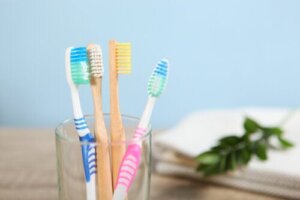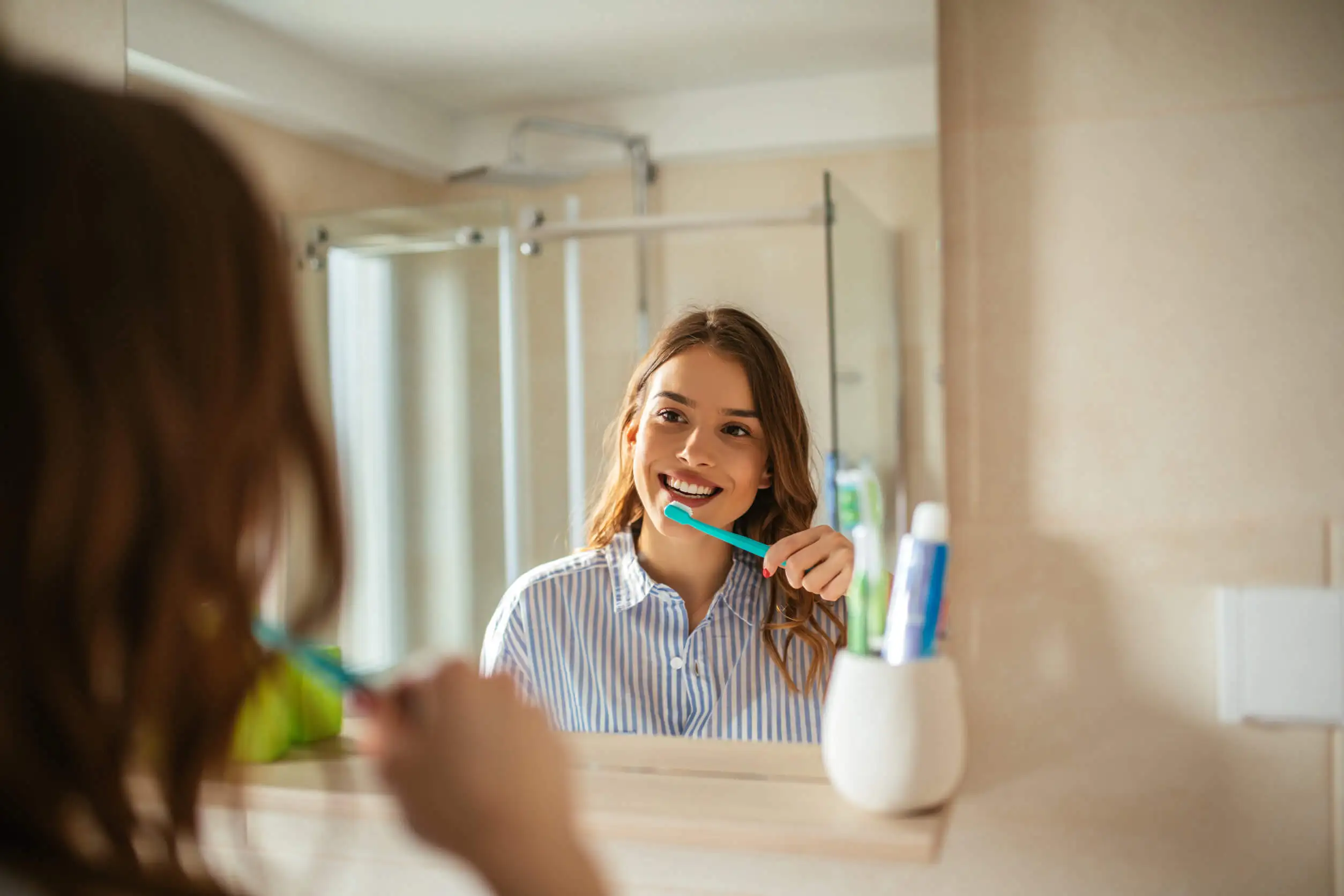Plastic versus. Bamboo Toothbrushes: Advantages and Disadvantages


Written and verified by the dentist Vanesa Evangelina Buffa
A wide variety of dental hygiene instruments are now available. In stores, you can now find classic plastic toothbrushes or new bamboo toothbrushes. The latter have gained popularity because they’re considered to be environmentally friendly.
However, plastic toothbrushes have historically been the most widely accepted option. The variety of designs, sizes, colors, and indications have allowed everyone to choose the element that best suits their mouth and their budget. The problem is that their environmental impact has not been determined.
Since they need to be replaced every three months, they’re a major source of waste. In response to this, options have been launched on the market that try to reduce the damage, such as bamboo toothbrushes. So, what do you need to know about them? We’ll tell you more about each option and its advantages and disadvantages.
The features of plastic and bamboo toothbrushes
At first glance, plastic toothbrushes and bamboo toothbrushes differ greatly. The manufacturing material, appearance, and packaging of each are very different when compared. In addition to this, there are other characteristics that are not visible at the time of purchase, but which also differentiate them. Let’s take a look at them in detail.
Plastic toothbrushes
Plastic toothbrushes have been on supermarket and drugstore shelves for several years. Over time, new designs have appeared – with different shapes, sizes, and consistencies – to suit not only individual needs, but also various budgets.
In fact, this is one of their greatest advantages. They’re accessible and easy to find everywhere. In addition, the development of new designs allows them to be applied to specific features or dental problems.
They last for about three months. After this period – or before if the bristles deteriorate or the person suffers any other eventuality – it’s recommended to discard and replace them.

So, what is their disadvantage?
Undoubtedly, the material they are made of. Their handles are made of PVC plastic, which is derived from petroleum. Sometimes, these toothbrushes contain rubber. Meanwhile, the bristles are made of nylon. They’re therefore a waste problem. And that’s not to mention their packaging, which also often has plastic packaging covering the brush.
These plastic materials take at least 75 years to decompose. However, it can take more than 400 years for them to fully degrade. In fact, they never disappear, as they break down into microplastics that are harmful to health and the environment.
Many animals, especially seabirds and birds, consume these microplastics. So do people. And although there’s no concise evidence about their effects, everything points to the fact that they can lead to serious health problems.
It’s true that the plastic and other toothbrush compounds could be recycled separately. It’s then necessary to split these components. However, due to the strong bonding with which they are manufactured, this is not always possible.
We think you may also enjoy reading this article: What Do the Color Marks on Toothpaste Tubes Mean?
The features of bamboo toothbrushes
Bamboo toothbrushes have recently emerged as a more environmentally friendly option compared to plastic brushes. They have the same effectiveness in removing bacterial plaque from the mouth.
They have a resistant handle made of bamboo, one of the plants with the highest growth rate in the world, which facilitates its cultivation and use for manufacturing.
Regarding bristles, there are different options. There are some commercial brands whose filaments are still made of nylon, or nylon combined with vegetable oils or activated charcoal. On the other hand, bioplastic bristle options make the brush 100% degradable.
Due to its manufacturing material, its main advantage is that this type of toothbrush is biodegradable. It can be put in compost to be integrated back into the soil. Thus, it takes about 180 days to decompose. That’s much less than the 75 to 400 years that plastic takes.
In the case of brushes containing nylon bristles, these can be easily removed from the handle for recycling. They should be removed with tweezers and placed in a special container for plastics.
The presentation of bamboo brushes for sale does not usually contain plastic, either. They’re often available in a simple cardboard box that is also biodegradable. Also, some brands choose to market them in 100% cotton ecological bags.
Like plastic brushes, bamboo brushes should be changed every three months. One of the disadvantages is their higher cost, so their replacement can have an impact on the household economy.
Some important facts about bamboo
The use of bamboo for brushes provides other positive benefits for the environment. During its growth, this plant is capable of using large amounts of carbon dioxide (CO2), one of the gases responsible for the greenhouse effect.
In addition, this plant grows very fast and doesn’t need to be cut down to use it. Its branches are simply cut and then sprout again. Bamboo shoots remain after harvesting and reach a mature size after a few months.
So, there’s no need to replant or use artificial irrigation. In addition, the presence of naturally occurring antibacterial agents in this plant prevents the need to use fertilizers or pesticides in its cultivation.
It’s worth mentioning that some brands use this information about the plant’s antimicrobial properties to advertise. They claim that this gives bamboo toothbrushes greater resistance against mouth germs. However, this is not yet proven.
In fact, a study comparing Candida retention on plastic and bamboo toothbrush heads showed a slightly greater proliferation of the fungus on bamboo toothbrushes. The results are not significant for health, but it’s still a useful piece of information to avoid misleading advertising.
Another disadvantage of using bamboo in toothbrushes is that bamboo is grown in wild forests in China. Therefore, there’s a long way to go for this material to reach other countries.
Like this article? You may also like to read: Why You Should Use Toothpaste with Coconut Oil
Beware of false advertising
Due to the increased interest of the population in caring for the planet, several ecological alternatives have appeared in oral hygiene products. However, it’s necessary to have some knowledge to avoid falling into the deception of some advertisements.
After all, not all brands of bamboo toothbrushes are completely environmentally friendly. If you’re looking for a 100% eco-friendly option, there are a few things to consider.
The material the bristles of the brush are made of is one factor to consider. Nylon in the brush head is not an entirely eco-friendly option, as this is a petroleum derivative. As we told you, this part of the brush is not degradable. It’s waste and you should look for the right way to recycle it.
You should look for brushes made of bioplastics. These are new materials that are made from natural polymers, which arise from environmentally compatible products, without using fossil fuels. They’re resistant and versatile like plastic, but degradable.
There are not many options on the market that use bioplastics. Filaments made from castor oil are one of the available proposals being used by some brands.
Another aspect to be valued is the certification seals that guarantee the veracity of the zero ecological impact of the product and its manufacture. The presence of the word “eco” or the green color in the brand is not enough to guarantee a product is really environmentally friendly.
It’s also important to pay attention to the packaging of the product. There’s no point in looking for an ecological toothbrush if its packaging is a garbage problem. In addition, it should have details of its composition, as this facilitates responsible waste management. In this regard, be careful with brands that don’t provide this information.

Bamboo vs. plastic toothbrushes: A necessary change
Both plastic and bamboo toothbrushes are capable of properly sanitizing the mouth. Choosing one or the other variety depends on the needs of your mouth, your budget, and your commitment to caring for the planet.
Looking for options that take care of your mouth and at the same time help the planet is finally a possibility. Small changes in our daily lives can contribute to making us all a little better off.
All cited sources were thoroughly reviewed by our team to ensure their quality, reliability, currency, and validity. The bibliography of this article was considered reliable and of academic or scientific accuracy.
- Rodríguez González, R. (2021). Revisión exploratoria de la presencia de microplásticos en bebidas de consumo humano:¿ un potencial problema de salud a gran escala?.
- Sarria-Villa, R. A., & Gallo-Corredor, J. A. (2016). La gran problemática ambiental de los residuos plásticos: Microplásticos. Journal de Ciencia e Ingeniería, 8(1), 21-27.
- Mistry, K. A double-blind trial comparing the plaque removal ability of a bamboo toothbrush and a plastic toothbrush.
- Avila Cotrina, S. (2021). Cepillo dental ecológico de bambú y eliminación del biofilm dental de los estudiantes de la Facultad de Odontología de la Universidad Nacional Mayor de San Marcos.
- Sarmiento Fadul, M. F. (2021). Carbón activado en productos de higiene dental (Bachelor’s thesis, Universidad de Guayaquil. Facultad Piloto de Odontología).
- Avaneethram, A. R., Peedikayil, F. C., Chandru, T. P., Kottayi, S., Aparna, T. P., & Ismail, S. (2021). Retention of Candida Species on Plastic and Bamboo Toothbrushes. A Comparative Study. Dentistry and Medical Research, 9(2), 73.
- AlDhawi, R. Z., AlNaqa, N. H., Tashkandi, O. E., Gamal, A. T., AlShammery, H. F., & Eltom, S. M. (2020). Antimicrobial efficacy of charcoal vs. non-charcoal toothbrushes: A randomized controlled study. Journal of International Society of Preventive & Community Dentistry, 10(6), 719.
- Thakur, A., Ganeshpurkar, A., & Jaiswal, A. (2020). Charcoal in dentistry. Natural Oral Care in Dental Therapy, 197-209.
- Benavente Jiménez, M., & Padrón Ponce, R. (2021). Comparación de las expectativas y satisfacción de los usuarios de cepillos dentales eco-amigables versus de plástico (Doctoral dissertation, Universidad Nacional Pedro Henríquez Ureña).
- Ramos Munera, A. (2021). Exposición a microplásticos. Efectos sobre la salud y el medio ambiente.
- Punyauppa-path, P. (2020). Microplastics: Origin, Environmental impact, Food and Beverage contamination and Management methods. Naresuan University Journal: Science and Technology (NUJST), 28(2), 72-80.
This text is provided for informational purposes only and does not replace consultation with a professional. If in doubt, consult your specialist.








